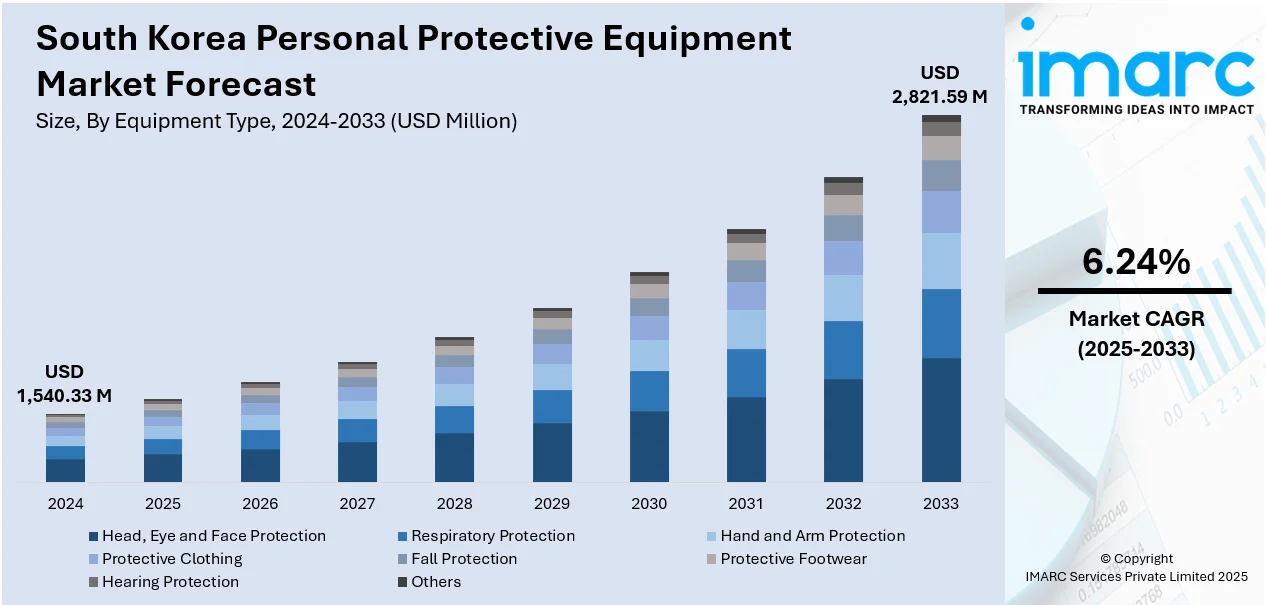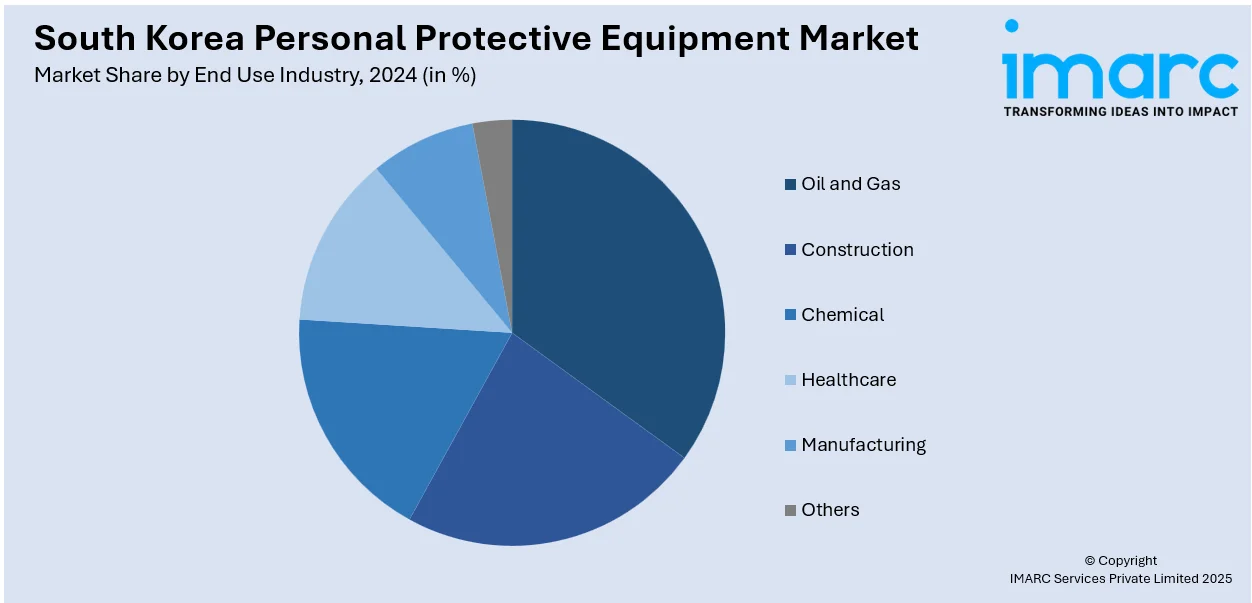
South Korea Personal Protective Equipment Market Size, Share, Trends and Forecast by Equipment Type, End Use Industry, and Region, 2025-2033
South Korea Personal Protective Equipment Market Overview:
The South Korea personal protective equipment market size reached USD 1,540.33 Million in 2024. The market is projected to reach USD 2,821.59 Million by 2033, exhibiting a growth rate (CAGR) of 6.24% during 2025-2033. Technology innovation, climate change, and globalization are the three large drivers remaking industries and societies. Climate change fuels sustainability forces that pressure governments and companies into green and resilience-first strategies for long-term development. These forces as a whole affect strategy, regulation, and customer behavior, necessitating that organizations change quickly in order to be competitive, accountable, thereby supporting the South Korea personal protective equipment market share.
|
Report Attribute
|
Key Statistics
|
|---|---|
|
Base Year
|
2024
|
|
Forecast Years
|
2025-2033
|
|
Historical Years
|
2019-2024
|
| Market Size in 2024 | USD 1,540.33 Million |
| Market Forecast in 2033 | USD 2,821.59 Million |
| Market Growth Rate 2025-2033 | 6.24% |
South Korea Personal Protective Equipment Market Trends:
Ongoing Technological Innovation
Technological innovation is a major driver in the South Korea personal protective equipment market trends changing across industries, enabling new products, services, and business models that often disrupt traditional markets. Advances in AI, automation, renewable energy, and biotechnology are transforming operations and consumer experiences. AI alone is projected to contribute nearly $19.9 trillion to global GDP by 2030, up from $1.2 trillion in 2024, highlighting its immense economic impact. These innovations boost efficiency, reduce costs, and offer competitive advantages artificial intelligence (AI), for instance, is revolutionizing healthcare diagnostics, while automation enhances manufacturing. However, rapid innovation also presents challenges, including job displacement and cybersecurity risks. Organizations that embrace and adapt to emerging technologies are better positioned for success, while those that don’t may fall behind. In the 21st century, technological progress is not only shaping economic performance and competitiveness but also redefining the future of work, sustainability, and global development.

To get more information on this market, Request Sample
Rising Globalization
Globalization is the growing interconnectedness of populations, cultures, and economies through investment, trade, communication, and technology. Globalization facilitates the movement of goods, services, information, and people to travel across borders. With global business serving as a key economic growth driver, globalization provides businesses with access to new markets, access to global supply chains, and more cost-efficient production . Globalization fosters cross-cultural interaction and can spur innovation through international cooperation. Though, it also heightens competition, reveals weaknesses in international supply chains, and has the potential to increase income inequality. Pandemics or political tensions may derail globalization, but the trend is at the heart of contemporary commerce and diplomacy. For corporations and governments, globalization means finding a balance between worldwide opportunities and local interests. Adjustment to and knowledge of this driver are essential for sustainable development, competitive edge, and long-term resilience in a complicated, interconnected world.
Climate Change and Sustainability
Sustainability and climate change are today central driver influencing economies, business models, regulations, consumerism, and consumer behavior. Increasing global temperatures, weather extremes, and loss of biodiversity are compelling governments and organizations to adopt environmental stewardship. Customers are on the rise, demanding sustainable products and fair practices. Regulators are implementing tougher environmental standards, and investors are turning toward ESG (Environmental, Social, and Governance) parameters. For businesses, sustainability is no longer a choice—it's a competitive imperative. Those companies innovating with green technology, minimizing carbon footprints, and embracing circular economy models are setting themselves up for success. Those that ignore environmental issues, on the other hand, risk reputational harm, legal challenges, and obsolescence. Climate change endangers not only ecological stability but also economic and social systems and is therefore a main driver of change in policy, business, and international cooperation.
South Korea Personal Protective Equipment Market Segmentation:
IMARC Group provides an analysis of the key trends in each segment of the market, along with forecasts at the country and regional levels for 2025-2033. Our report has categorized the market based on equipment type, and end use industry.
Equipment Type Insights:
- Head, Eye and Face Protection
- Respiratory Protection
- Hand and Arm Protection
- Protective Clothing
- Fall Protection
- Protective Footwear
- Hearing Protection
- Others
The report has provided a detailed breakup and analysis of the market based on the equipment type. This includes head, eye and face protection, respiratory protection, hand and arm protection, protective clothing, fall protection, protective footwear, hearing protection, and others.
End Use Industry Insights:

- Oil and Gas
-
- Head, Eye and Face Protection
- Respiratory Protection
- Protective Clothing
- Hand and Arm Protection
- Protective Footwear
- Fall Protection
- Hearing Protection
- Others
- Construction
-
- Head, Eye and Face Protection
- Respiratory Protection
- Protective Clothing
- Hand and Arm Protection
- Protective Footwear
- Fall Protection
- Hearing Protection
- Others
- Chemical
- Head, Eye and Face Protection
- Respiratory Protection
- Protective Clothing
- Hand and Arm Protection
- Protective Footwear
- Others
- Healthcare
- Head, Eye and Face Protection
- Respiratory Protection
- Protective Clothing
- Hand and Arm Protection
- Others
- Manufacturing
-
- Head, Eye and Face Protection
- Respiratory Protection
- Protective Clothing
- Hand and Arm Protection
- Protective Footwear
- Fall Protection
- Hearing Protection
- Others
A detailed breakup and analysis of the market based on the end use industry have also been provided in the report. This includes oil and gas (head, eye and face protection, respiratory protection, protective clothing, hand and arm protection, protective footwear, fall protection, hearing protection, and others), construction (head, eye and face protection, respiratory protection, protective clothing, hand and arm protection, protective footwear, fall protection, hearing protection, and others), chemical (head, eye and face protection, respiratory protection, protective clothing, hand and arm protection, protective footwear, and others), healthcare (head, eye and face protection, respiratory protection, protective clothing,hand and arm protection, and others), manufacturing (head, eye and face protection, respiratory protection, protective clothing, hand and arm protection, protective footwear, fall protection, and hearing protection), and others.
Regional Insights:
- Seoul Capital Area
- Yeongnam (Southeastern Region)
- Honam (Southwestern Region)
- Hoseo (Central Region)
- Others
The report has also provided a comprehensive analysis of all the major regional markets, which include Seoul Capital Area, Yeongnam (Southeastern Region), Honam (Southwestern Region), Hoseo (Central Region), and Others.
Competitive Landscape:
The market research report has also provided a comprehensive analysis of the competitive landscape. Competitive analysis such as market structure, key player positioning, top winning strategies, competitive dashboard, and company evaluation quadrant has been covered in the report. Also, detailed profiles of all major companies have been provided.
South Korea Personal Protective Equipment Market Report Coverage:
| Report Features | Details |
|---|---|
| Base Year of the Analysis | 2024 |
| Historical Period | 2019-2024 |
| Forecast Period | 2025-2033 |
| Units | Million USD |
| Scope of the Report |
Exploration of Historical Trends and Market Outlook, Industry Catalysts and Challenges, Segment-Wise Historical and Future Market Assessment:
|
| Equipment Types Covered | Head, Eye and Face Protection, Respiratory Protection, Hand and Arm Protection, Protective Clothing, Fall Protection, Protective Footwear, Hearing Protection, Others |
| End Use Industries Covered |
|
| Regions Covered | Seoul Capital Area, Yeongnam (Southeastern Region), Honam (Southwestern Region), Hoseo (Central Region), Others |
| Customization Scope | 10% Free Customization |
| Post-Sale Analyst Support | 10-12 Weeks |
| Delivery Format | PDF and Excel through Email (We can also provide the editable version of the report in PPT/Word format on special request) |
Key Questions Answered in This Report:
- How has the South Korea personal protective equipment market performed so far and how will it perform in the coming years?
- What is the breakup of the South Korea personal protective equipment market on the basis of equipment type?
- What is the breakup of the South Korea personal protective equipment market on the basis of end use industry?
- What is the breakup of the South Korea personal protective equipment market on the basis of region?
- What are the various stages in the value chain of the South Korea Perso personal protective equipment market?
- What are the key driving factors and challenges in the South Korea personal protective equipment market?
- What is the structure of the South Korea personal protective equipment market and who are the key players?
- What is the degree of competition in the South Korea personal protective equipment market?
Key Benefits for Stakeholders:
- IMARC’s industry report offers a comprehensive quantitative analysis of various market segments, historical and current market trends, market forecasts, and dynamics of the South Korea personal protective equipment market from 2019-2033.
- The research report provides the latest information on the market drivers, challenges, and opportunities in the South Korea personal protective equipment market.
- Porter's five forces analysis assist stakeholders in assessing the impact of new entrants, competitive rivalry, supplier power, buyer power, and the threat of substitution. It helps stakeholders to analyze the level of competition within the South Korea personal protective equipment industry and its attractiveness.
- Competitive landscape allows stakeholders to understand their competitive environment and provides an insight into the current positions of key players in the market.
Need more help?
- Speak to our experienced analysts for insights on the current market scenarios.
- Include additional segments and countries to customize the report as per your requirement.
- Gain an unparalleled competitive advantage in your domain by understanding how to utilize the report and positively impacting your operations and revenue.
- For further assistance, please connect with our analysts.
 Request Customization
Request Customization
 Speak to an Analyst
Speak to an Analyst
 Request Brochure
Request Brochure
 Inquire Before Buying
Inquire Before Buying




.webp)




.webp)












